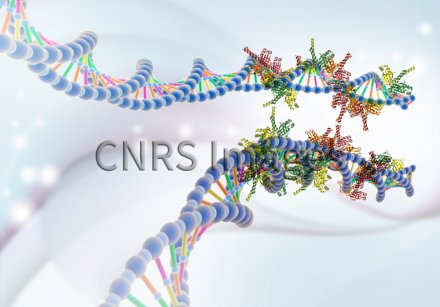Production year
2016

© Wilma TRALDI/Davide NORMANNO/CRCM/CNRS Images
20160085_0001
Artist’s impression showing that, when a DNA double strand break occurs, XRCC4 and XLF proteins form sheaths that slide very swiftly into place along the double helix like nano-repair patrols. As soon as a break is detected, two XRCC4-XLF patrols each grip one of the broken ends and then link up almost like Velcro to hold the two parts of the DNA molecule together in order to repair it. This phenomenon has been observed and noted by researchers seeking to understand how this nano-machine detects and repairs such breaks, which are especially dangerous for the cells. If breaks in DNA strands are not repaired correctly, they cause modifications to genetic information that can cause serious disease such as cancers. This fundamental discovery will ultimately allow us to detect and thence treat leukaemia as well as a number of other rare genetic syndromes.
The use of media visible on the CNRS Images Platform can be granted on request. Any reproduction or representation is forbidden without prior authorization from CNRS Images (except for resources under Creative Commons license).
No modification of an image may be made without the prior consent of CNRS Images.
No use of an image for advertising purposes or distribution to a third party may be made without the prior agreement of CNRS Images.
For more information, please consult our general conditions
2016
Our work is guided by the way scientists question the world around them and we translate their research into images to help people to understand the world better and to awaken their curiosity and wonderment.